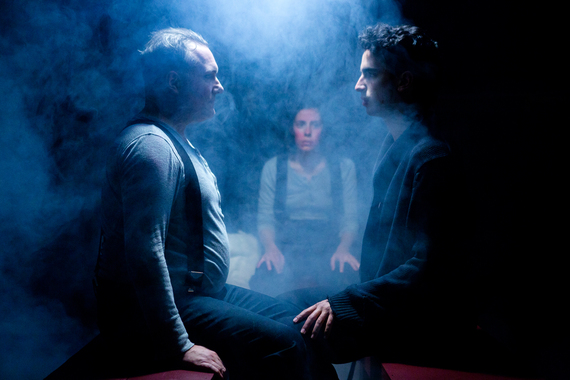
Dylan Marron, Christopher Borg, Cara Francis, Roberta Colindrez, and Cecil Baldwin in The Complete and Condensed Stage Directions of Eugene O'Neill, Vol. 2, produced by the New York NeoFuturists. Photo by Hunter Canning.
If you've ever read a play, you've probably wondered about those italicized parts of the script that mingle with the dialogue. (If you've never read a play, you should get on that, by the way.) But back to those italicized words, or "stage directions," as we theater folks call them. In my own acting days, I was always told that the first thing to do with those stage directions is to cross them out and ignore them. Eugene O'Neill, that melancholy Irish-American giant of a playwright, rolls over in his grave every time someone says that. You see, O'Neill doesn't write the kind of stage directions that instruct the actor to put down a cup or cross to a door, but instead uses his stage directions to say things like, "THE BUSINESS MAN edges away from THE POET, firmly convinced that his convictions regarding the similarity of poets and madmen are based upon fact."
Obviously, this kind of stage direction shouldn't be ignored, but how would you perform such a sentiment on stage? Will the audience get it? Two years ago, the intrepid New York Neo-Futurists decided to do something a bit different. Instead of performing scripts where the stage directions were crossed out or ignored or simply left unspoken, they decided to cross out the dialogue and leave the stage directions. The result was the immensely popular show The Complete & Condensed Stage Directions of Eugene O'Neill: Volume 1 Early Plays/ Lost Plays. The show ran at the Kraine Theater and was extended and then remounted due to the demand. I saw that production four times and have been hooked on everything NY Neo ever since.
As I've enjoyed getting to know the NY Neos and their work, I've become even more eager to see the next installment of this work. My own interest in stage directions means that I have spent a great deal of time discussing, analyzing, and looking forward to this NY Neo project. I have finally had the opportunity to see The Complete & Condensed Stage Directions of Eugene O'Neill: Volume 2, and I couldn't be happier that this innovative series is back in New York City!
Director and adaptor Christopher Loar has once again chosen a series of O'Neill plays that have an impressive scope of stage directions. Here we are treated to Recklessness (1913), Warnings (1913), Fog (1914), Abortion (1914), and The Sniper (1915), which are all performed by four actors: Christopher Borg, Roberta Colindrez, Cara Francis, and Dylan Marron. The voice of Welcome to Night Vale, Cecil Baldwin, reads O'Neill's missives to the audience and actors. The performers utilize the wide stage at the Cino Theater (in Theater for the New City) as an extensive playground for the various instructions given.

Christopher Borg, Roberta Colindrez, and Dylan Marron. Photo by Hunter Canning.
The stage morphs as O'Neill layers instruction upon instruction as the performers construct a version of the physical space, detailed personalities, and required emotional instructions that comprise each of the plays listed. Baldwin's smooth, noir-like delivery is juxtaposed with the frantic movements of the performers who jump at the opportunity to execute O'Neill's instructions. This combination of energy is a continuation of the first version of Complete & Condensed, though it is slightly dissipated by the larger space of the Cino. In the Kraine Theater, the audience felt the strain of the expansive stage directions being contained to a small stage, very close to a cozy audience. The abundance of space in the Cino means that the audience is more distanced from what was happening, which is not necessarily bad, but simply different from the audience relationship that existed in the first volume.
Yet this production also builds on what was done in the first volume. One of the greatest innovations here is the doubling performed by some of the actors. Marron, for example, has an entire scene in which he plays both characters involved in a discussion. The result is absolutely hilarious, as he must remember to take on all of the detailed physical descriptions of each character every time he has to add another stage direction to them.
This volume is also much more in touch with the fact that these stage directions alone can be either hilariously outrageous or devastatingly effective. In the final play of the evening, The Sniper, the stage directions are not fought against in the manner in which they are in the other plays. In other words, we laugh at the other plays not because the directions are meant to be funny, but rather because the ways the performers are interpreting them point out how words can be simultaneously insufficient and overbearing. In The Sniper, we see that the stage directions can also set the mood entirely without spoken dialogue. While in most of the plays reading the stage directions alone creates an alternative play, in The Sniper it simply creates a concise version of the original.
Overall, the NY Neos have once again pulled back the curtain to reveal the unspoken and under-appreciated world of Eugene O'Neill's stage directions. If you are looking for a night of theatre that will make you laugh as well as think, then go and head over to the visual and auditory feast that is The Complete & Condensed Stage Directions of Eugene O'Neill: Volume 2. I know I'll be going back to appreciate the brilliant performers, the excellent direction, and the words from that playwright who was a living example of the relation of poets and madmen.